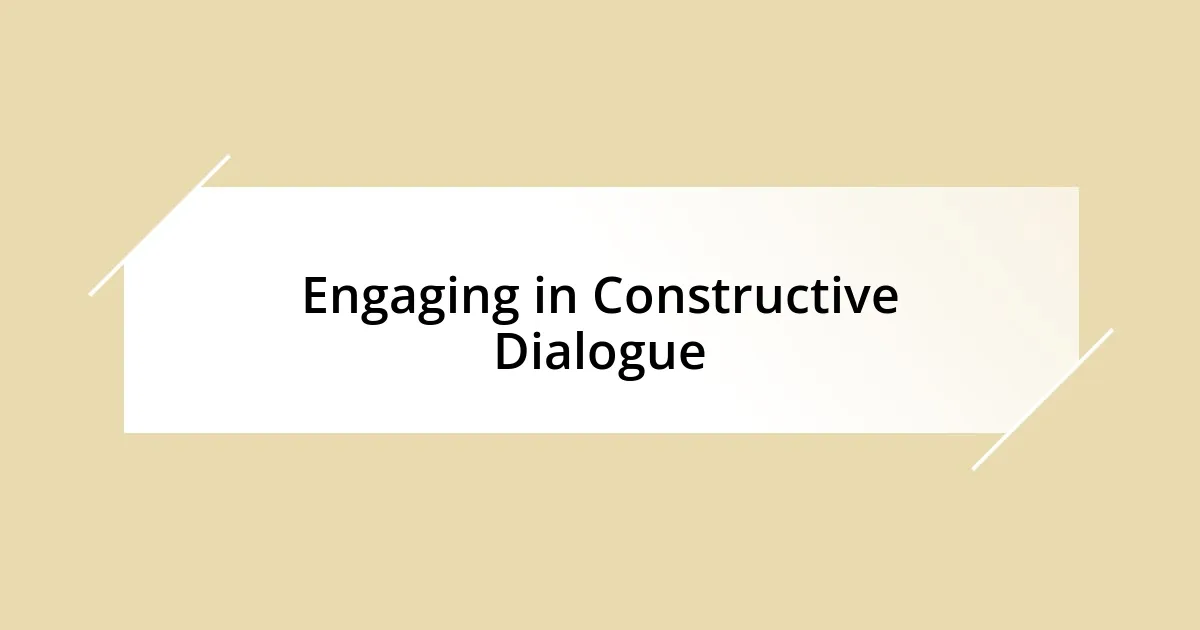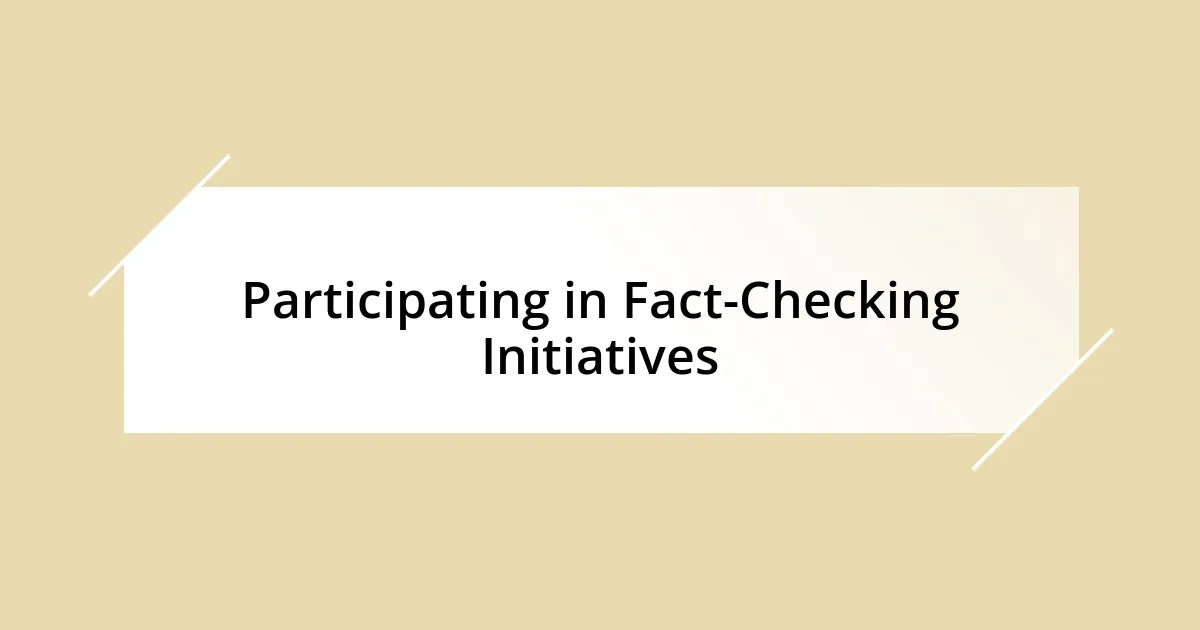Key takeaways:
- Misinformation can erode public trust and significantly affect emotional responses to critical issues.
- Identifying reliable information sources involves checking domains, authorship, language, and verifying facts.
- Engaging in constructive dialogue, rather than dismissing concerns, fosters mutual understanding and facilitates learning.
- Participating in fact-checking initiatives empowers individuals and communities to actively combat misinformation and promote informed discussions.

Understanding Misinformation Effects
Misinformation can create a ripple effect, touching lives in ways we often don’t recognize. I remember a time when a misleading social media post about a local event caused a frenzy in my community, leading to canceled plans and unnecessary panic. Isn’t it unsettling to think how quickly false information can distort our understanding of reality?
When misinformation seeps into public discourse, it can erode trust—not just in the information itself, but in the institutions that provide it. Reflecting on my experiences, I’ve seen friends become skeptical of health information during a crisis, questioning the very data meant to protect them. How can we rebuild that trust once it’s shattered?
The emotional impact of misinformation is profound. I recall feeling frustrated when a family member clung to unfounded claims about a critical issue, despite evidence to the contrary. It made me wonder: how do we bridge the gap between fact and belief when emotions run so high? Understanding these effects can be the first step in combating misinformation effectively.

Identifying Misinformation Sources
Identifying the sources of misinformation can be quite challenging, especially when the content seems credible at first glance. I remember stumbling upon a well-designed website that provided “facts” about a popular health topic, only to later find out it was a front for an agenda. It’s a jarring reminder that we must scrutinize our sources, as appearances can be deceiving.
Here’s a useful checklist to help you identify questionable sources of information:
- Check the domain: Educational (.edu) and government (.gov) sites typically offer reliable information, while personal blogs may not.
- Look for authorship: Who wrote it? Check their credentials and affiliations.
- Analyze the language: Sensationalized language often indicates bias or intent to mislead.
- Verify with reliable sources: Cross-reference information with respected organizations or fact-checking sites.
- Assess publication dates: Ensure the information is current and relevant.
By employing these strategies, we can cultivate a more discerning eye for the information we consume.

Evaluating Information Credibility
Evaluating the credibility of information is crucial in our fight against misinformation. I often find myself asking, “Does this story feel right?” when I encounter news articles or social media posts. Once, I came across a viral tweet claiming a controversial event had taken place. The sensational headline grabbed my attention, but a quick check of reputable news sources revealed it was entirely fabricated. That experience taught me the importance of pausing and reflecting on the information before sharing it.
When assessing credibility, I hone in on a few key elements. First, I consider the author’s background and the organization’s reputation. For example, I once disregarded an article because the author was a self-proclaimed expert without any relevant qualifications. Similarly, looking for peer-reviewed articles in academic journals can provide a more reliable foundation than opinion pieces or personal blogs. In my experience, a little bit of research can save us from spreading misinformation unknowingly.
Understanding bias is also important in evaluating credibility. I recall a time when I shared an article from a source I loved without looking deeper. My close friend, who is particularly critical of media bias, pointed out the author’s political affiliations and how they tinted the narrative. This taught me to approach information with a critical mindset, evaluating not just the content but also the potential influence of the source behind it.
| Evaluation Criteria | Examples |
|---|---|
| Author Credentials | Check if the author has relevant expertise or qualifications. |
| Source Reputation | Is it from a well-established organization or a random blog? |
| Language Used | Sensationalized or emotional language may indicate bias. |
| Cross-Verification | Is the information corroborated by reliable sources? |
| Publication Date | Ensure the information is current and relevant. |

Using Critical Thinking Skills
When it comes to using critical thinking skills, I find that asking the right questions can make all the difference. Picture this: I recently came across a Facebook post claiming that a major company was going bankrupt. My first instinct was to click “share,” but something didn’t quite sit right. Instead, I paused and asked myself, “What’s the evidence here? Is there a credible source backing this claim?” This moment of reflection helped me dig deeper rather than just reacting impulsively.
I’ve learned that engaging actively with the information is key. For instance, during a heated discussion about climate change, a friend cited a study that seemed shocking. Instead of taking it at face value, I inquired about the study’s methodology and funding sources. By doing this, I uncovered that the research had significant conflicts of interest, which they hadn’t disclosed. It’s instances like these that reinforce the importance of not just absorbing information but questioning it—because our understanding relies heavily on context and transparency.
Moreover, I sometimes use a mental checklist when confronted with dubious claims. I recall an eye-opening experience with a viral health tip that promised miraculous results. By applying my critical thinking skills, I traced the advice back to its origins and found a lack of scientific validation. This taught me that not all knowledge is created equal, and I should always ask, “Does this make sense logically?” Trusting my intuition alongside solid reasoning has helped me not only protect myself from misinformation but also empowered me to engage others in meaningful conversations about reliability and truth.

Engaging in Constructive Dialogue
Sometimes, engaging in constructive dialogue feels like walking a tightrope. I remember a particular conversation about vaccine misinformation at a family gathering. Rather than dismissing the doubts raised by my uncle outright, I chose to ask him why he felt that way. This approach shifted the tone from a defensive argument to a collaborative investigation. It made me realize how critical it is to foster an environment where concerns are acknowledged and discussed, rather than overlooked.
During these discussions, I’ve found that sharing my own experiences can open up the dialogue further. For example, I recounted how my research into vaccines revealed layers of scientific evidence that I initially hadn’t been aware of. Asking him, “Have you considered how robust the data supporting these vaccines is?” sparked curiosity rather than defensiveness. It underscored that sharing personal insights, rather than merely presenting facts, often cultivates deeper understanding and connection.
I can’t help but reflect on how empathy plays a role in these conversations. When my colleague expressed doubts about climate change, I didn’t just bombard them with statistics. Instead, I asked about their experiences and concerns regarding environmental changes in our community. It’s a simple yet profound reminder that we all come to the table with our own stories and biases. Through this lens, I’ve learned that engaging in constructive dialogue isn’t just about exchanging information; it’s about creating a space for growth and mutual understanding.

Sharing Accurate Information Strategies
Sharing accurate information strategies often begins with the act of verifying sources. I remember encountering a sensational headline about a celebrity’s controversial behavior. My first reaction was to hit “share,” but then I paused to consider the implications of spreading unverified gossip. What if it wasn’t true? This thought led me on a quick hunt for reliable news outlets and fact-checking websites. I’ve found that taking a few extra minutes to confirm the legitimacy of information can prevent the spread of misinformation and help shape a more informed community.
In my experience, using visuals can also enhance the way we share accurate information. Once, during a community forum on health practices, I presented a simple infographic that laid out the facts about nutrition alongside common myths. The audience visibly engaged with the visuals, sparking discussions that questioned previously held beliefs. It made me realize how powerful clear, accessible visuals can be in bridging gaps of understanding. When we present information in a digestible format, we invite others to not just receive data but to interact with it.
Listening plays a surprisingly vital role in effectively sharing accurate information. I often recall a heated debate I had at a local meetup on social media’s impact on mental health. Instead of merely presenting facts, I made it a point to first listen to others’ experiences and perspectives. This helped me tailor my responses to address their concerns directly. But it also reminded me that sharing accurate information isn’t just about what you say; it’s about creating a dialogue where everyone feels heard. Have you ever noticed how much more receptive people are when they feel their voices matter?

Participating in Fact-Checking Initiatives
Participating in fact-checking initiatives can be enlightening and empowering. I joined a local group dedicated to verifying social media claims, and the experience was eye-opening. There was one instance where we tackled a viral post about a health scare. After digging through various reputable sources, I felt a sense of accomplishment when we debunked the myth, knowing we were protecting our community from unnecessary panic.
Engagement in these initiatives also fosters a sense of community collaboration. I vividly recall a session where our group pooled resources to address misinformation regarding local environmental issues. As we worked together, I saw people transform from passive consumers of information into active participants in the pursuit of truth. It was a beautiful reminder that fact-checking isn’t just a solitary effort; it’s a shared commitment to integrity that can spark a ripple effect within our circles.
One of the most valuable lessons I’ve learned through fact-checking is the importance of patience and thoroughness. There was a moment when a friend forwarded me a particularly sensational article about a political event. Instead of reacting in haste, I took the time to research, validating each claim meticulously. This not only granted me clarity but also enabled me to explain the truth to my friend calmly. Have you ever found the power in taking that extra moment to dig deeper? It reinforces the idea that careful fact-checking is integral in countering misinformation, one thoughtful discussion at a time.














